Unparalleled Importance of E-commerce Website Design in the Digital Age
![]()
In today’s fast-paced world, an online presence for any business is more than an option, it’s an absolute necessity.
Among these, e-commerce website design plays a pivotal role as the backbone of electronic commerce.
The era of physical sales alone is over; today, consumers expect to be able to easily purchase the products and services they need, anytime and anywhere, with just a few clicks.
A standard #e-commerce_website is not just a showcase for your products, but also a platform for interacting with customers, collecting data, and analyzing their behavior.
Have you ever thought about how a physical store can overcome geographical and temporal limitations? The answer lies within #e-commerce and the development of an efficient online store.
Ignoring this immense potential means losing a significant market share and ceding ground to competitors who have invested in the digital space.
The ability for #global_access and your store being open 24/7 creates an unparalleled competitive advantage.
This platform allows businesses to reach a wider audience at a much lower cost compared to establishing multiple physical branches, ultimately paving the way for sustainable growth and development.
Is your company’s website as professional and trustworthy as it should be? With specialized corporate website design by Rasawweb, create an online presence that represents your credibility and attracts more customers.
✅ Build a powerful and professional image for your brand
✅ Convert visitors into real customers
⚡ Get a free consultation now!
Key Components of a Professional E-commerce Website
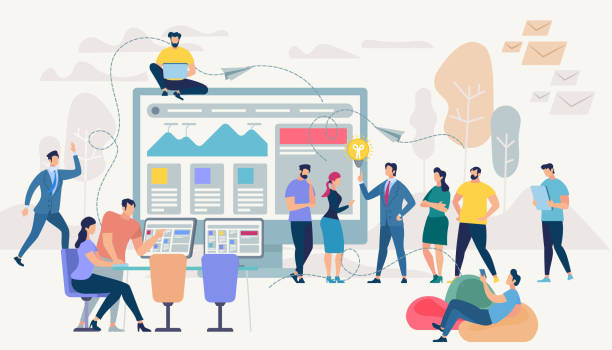
A successful e-commerce website design is not limited to its visual appearance; it requires strong infrastructures and functional components that provide an optimal user experience.
The core of any online store is the product management system, which allows for adding, editing, and categorizing products along with complete details such as price, inventory, images, and descriptions.
After that, “shopping cart” gains importance; this section should be easy to use and allow customers to easily manage selected products.
One of the most vital components is a “secure payment gateway,” which must utilize advanced security protocols (such as SSL) and support various payment methods (bank cards, e-wallets, etc.) to gain customer trust.
A “user panel” also allows customers to view purchase history, track orders, and manage personal information.
Sections such as advanced search, product filters, review and rating systems, and product comparison also significantly help improve the shopping experience.
Ignoring any of these components can lead to a decrease in conversion rates and customer dissatisfaction.
The design of an e-commerce website should ensure that these components work seamlessly and flawlessly, making the purchasing journey smooth and enjoyable for the user.
Choosing the Best Platform for E-commerce Website Design
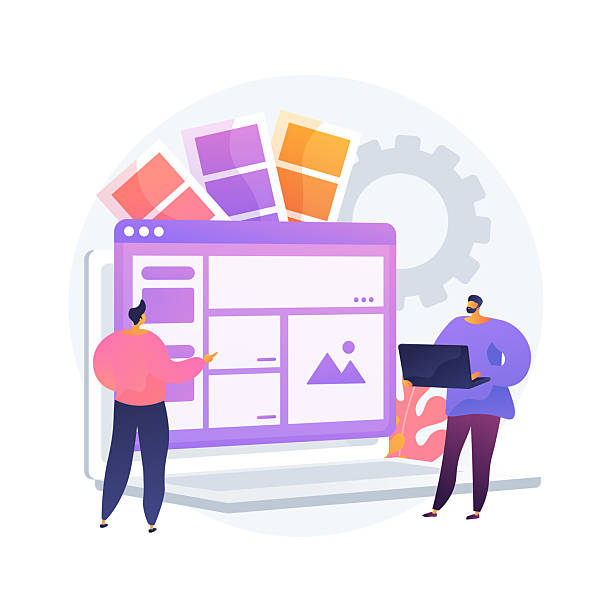
One of the key decisions in the e-commerce website design process is choosing the right platform.
This choice affects not only costs and development time but also the future capabilities and scalability of your store.
There are various platforms for creating online stores, each with its own advantages and disadvantages.
For example, WooCommerce, which is a WordPress plugin, is very popular due to its high flexibility, large user community, and low initial costs.
However, for larger stores with more complex needs, platforms like Shopify with cloud services and ready-made features, or Magento for deep customizations and high scalability, are better options.
The platform choice should be based on your product volume, budget, technical expertise level, and future business plans.
Do you need full control over the code, or will a ready-made solution suffice? Each platform offers different advantages in terms of SEO, security, and support, which should be carefully reviewed.
E-commerce website development requires careful consideration of all these factors.
| Platform | Advantages | Disadvantages | Ideal Use Cases |
|---|---|---|---|
| WooCommerce | High flexibility, free (plugin), large user community, SEO friendly. | Requires hosting and technical knowledge, more complex maintenance, scalability for very high volume is difficult. | Small to medium businesses, those familiar with WordPress. |
| Shopify | Ease of use, strong support, high security, no need for hosting technical knowledge. | Monthly fee, limitations in deep customization, transaction fees (in some plans). | Startups, small to medium businesses, dropshipping stores. |
| Magento | Very high scalability, infinite customization possibilities, suitable for large companies. | High complexity, requires specialized developer, high maintenance and development costs. | Large businesses with complex needs and high traffic volume. |
The Role of User Experience and User Interface in Online Store Success
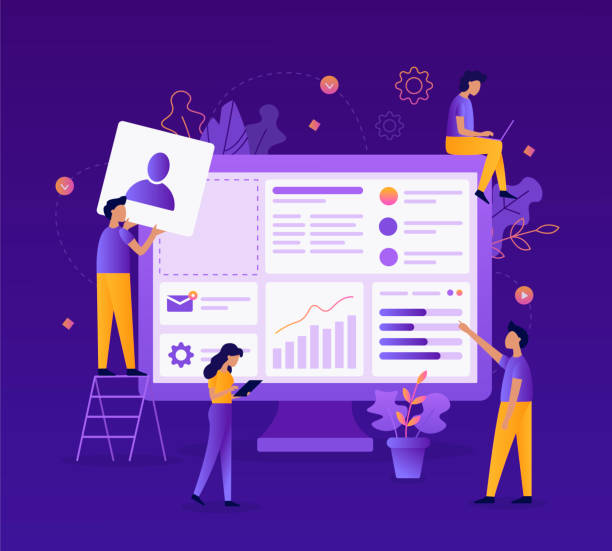
After platform selection, User Experience (UX) and User Interface (UI) aspects become critically vital in e-commerce website design.
User Interface (UI) refers to the look and feel of the website; it includes colors, fonts, images, and overall layout, which should be attractive and harmonious.
But User Experience (UX) goes beyond appearance; it deals with how users interact with the site, ease of navigation, page load speed, and the smoothness of the purchasing process.
A poor UX design can lead to high bounce rates and abandoned shopping carts, even if your products are excellent.
Users should be able to easily find their desired product, access sufficient information, and complete the payment process without complexity.
Responsive design, which optimizes the website for display on various devices (mobile, tablet, desktop), is now a requirement, not an option.
Page load speed is also very effective in retaining users and improving SEO rankings.
Continuous reviews and user testing can help identify weaknesses and continuously improve the user experience.
Focusing on these two aspects ensures that customers not only visit your website but also become loyal customers and complete their purchases.
Are you tired of losing business opportunities due to not having a professional corporate website?
Rasawweb helps you by designing professional corporate websites:
✅ Build a powerful and reliable image for your brand
✅ Convert website visitors into loyal customers
⚡ Get a free consultation now!
Search Engine Optimization (SEO) in E-commerce Website Design
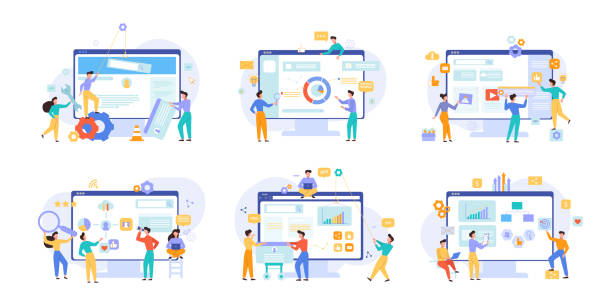
Having a beautiful and functional e-commerce website is useless without being seen by the target audience.
This is where Search Engine Optimization (SEO) in e-commerce website design becomes important.
SEO refers to a set of actions that help improve your site’s ranking in Google search results and other engines.
For an online store, this means attracting organic and targeted traffic, which has a very high probability of converting into customers.
The first step is keyword research related to your products; words that potential customers use to find your products.
These keywords should be used in product titles, descriptions, URL addresses, and meta descriptions.
Site load speed, responsive design, and SEO-friendly URL structure are among the technical factors that search engines prioritize.
Furthermore, producing high-quality content (e.g., blog articles about products or buying guides) and acquiring backlinks from reputable sites increases your site’s authority in the eyes of search engines.
Adhering to these principles helps your e-commerce website appear higher in search results and attract more traffic.
Security and Payment Gateways in E-commerce Websites
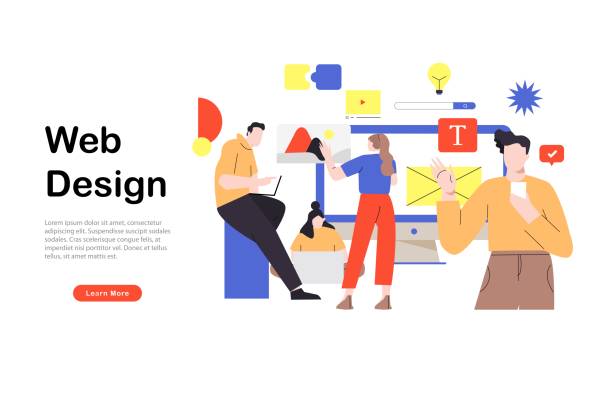
Security is one of the most important concerns in e-commerce website design.
Customers only make purchases if they trust the security of their personal and banking information.
Installing an SSL (Secure Sockets Layer) certificate, which encrypts communication between the user and the server, is the first and most fundamental step.
This certificate not only keeps information secure but also helps with website SEO and displays a green padlock symbol next to the site address, which builds user trust.
In addition to SSL, adherence to security standards such as PCI DSS (Payment Card Industry Data Security Standard) is essential for protecting bank card information.
Choosing a payment gateway also plays a key role; payment gateways must be secure, fast, and reliable.
In Iran, direct bank payment gateways or intermediary gateways (such as Zarinpal or IDPay) are commonly used, each with their own advantages and disadvantages.
Ensuring the correct functioning of the gateway, the absence of security bugs, and support for common bank card types are of high importance.
A small security vulnerability can lead to loss of customer trust and serious damage to your business’s reputation.
These issues should be considered from the outset in e-commerce website development.
Marketing and Advertising Strategies After E-commerce Website Design

After completing e-commerce website design, the next stage is customer acquisition and increasing sales.
Without effective marketing and advertising strategies, even the best online store cannot reach its full potential.
Digital marketing includes a wide range of tactics.
“Content marketing” by producing articles, videos, and guides related to your products helps attract organic traffic and build trust.
“Email marketing” is very effective for informing current and potential customers about campaigns, discounts, and new products.
“Social media marketing” with an active presence on platforms like Instagram, Telegram, and Twitter, provides the opportunity for direct interaction with the audience and building a community of loyal customers.
“Paid advertising” on Google (Google Ads) or social media (Social Media Ads) can quickly drive targeted traffic to your site.
Additionally, collaborating with influencers and affiliate marketing are effective methods for increasing visibility and sales.
It’s important to set up marketing campaigns based on precise data and analysis to maximize their effectiveness.
| Indicator (KPI) | Description | Importance |
|---|---|---|
| Conversion Rate | Percentage of visitors who convert into customers. | Most important success indicator; shows the effectiveness of the site and marketing. |
| Average Order Value (AOV) | The average amount each customer pays per order. | Improving this indicator can increase profitability without increasing the number of customers. |
| Bounce Rate | Percentage of visitors who leave the site after viewing one page. | Indicator of poor user experience or content not relevant to user needs. |
| Customer Acquisition Cost (CAC) | The average cost incurred to acquire a new customer. | Indicates the efficiency of marketing campaigns; should be less than the customer’s lifetime value. |
Data Analysis and Performance Monitoring of an Online Store
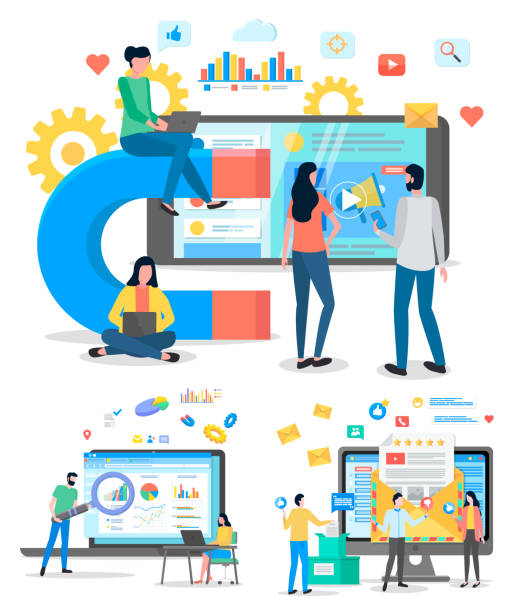
After launching and operating the store, continuous data monitoring and analysis are of high importance.
Tools like Google Analytics provide valuable information about user behavior on your site.
You can see where users came from (traffic source), what pages they viewed, how long they stayed on the site, and at which stages of the purchase process they left the site.
Analyzing this data helps you identify the strengths and weaknesses of your e-commerce website design and make data-driven decisions to improve performance.
For example, if the bounce rate on a specific page is high, that page might need redesign or content improvement.
If the conversion rate is low, the purchasing process or payment gateway might have issues.
Continuous monitoring of Key Performance Indicators (KPIs) such as conversion rate, average order value, and customer acquisition cost, allows you to measure the impact of implemented changes and optimize your marketing strategies.
This is an iterative process that helps the growth and sustainability of your online store.
Do you have an e-commerce site but your sales aren’t as expected? Rasawweb permanently solves your problem with professional e-commerce website design!
✅ Significant increase in conversion rate and sales
✅ Unparalleled user experience for your customers
⚡ Click here for a free consultation with Rasawweb!
Common Mistakes in E-commerce Website Design and Solutions to Avoid Them
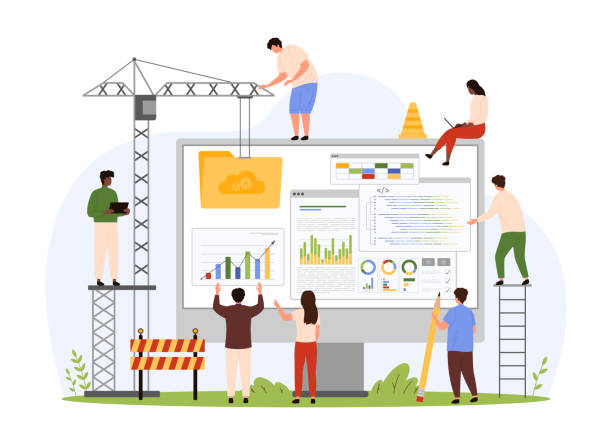
In the path of e-commerce website design, there are common mistakes that can harm business success.
One of the biggest mistakes is ignoring website load speed.
Today’s users are impatient, and a slow site quickly drives them away.
Using optimized images, clean coding, and powerful hosting can solve this problem.
Another mistake is poor user experience; complex navigation, insufficient product information, and a long and confusing payment process lead to abandoned shopping carts.
Simple, intuitive, and responsive design for all devices resolves this issue.
Lack of attention to security is also a major error that can lead to loss of customer trust and sensitive information; using SSL and regular updates of the platform and plugins are crucial.
Furthermore, lack of optimization for search engines (SEO) results in the site not being seen.
The absence of high-quality content and attractive images, as well as poor customer support after purchase, are other mistakes that should be avoided.
By being aware of these issues and planning carefully, you can create a successful and sustainable e-commerce website.
Future Trends in E-commerce and E-commerce Website Design
![]()
The world of e-commerce is constantly evolving, and being aware of future trends is crucial for maintaining a competitive advantage in e-commerce website design.
One of the most important trends is personalizing the shopping experience.
By using artificial intelligence and machine learning, stores can display specific products and offers to users based on their purchase history, interests, and behavior.
Augmented Reality (AR) and Virtual Reality (VR) are changing how products are displayed; for example, customers can virtually try on clothes or see furniture in their own home space.
Voice shopping through smart assistants like Google Assistant or Alexa is also growing, and businesses should be prepared for it.
Social Commerce, with the ability to purchase directly from social platforms, has also gained popularity.
Finally, attention to sustainability and social responsibility has also become an important factor in customer decision-making.
Adapting to these trends in e-commerce website development ensures that your online store remains relevant and appealing in the future and provides an engaging experience for users.
Frequently Asked Questions
| Question | Answer |
|---|---|
| What is e-commerce website design? | The process of creating an online platform for displaying, selling, and managing products or services to customers on the internet. |
| Why are UI and UX design important in an e-commerce website? | Good UI/UX design allows users to easily navigate the site, find their desired product, and complete the purchasing process without difficulty, which leads to increased sales and customer satisfaction. |
| What features should be included in a professional e-commerce website? | Comprehensive product catalog, user-friendly shopping cart, product comparison feature, strong filtering and search system, secure payment gateway, user panel, customer review section, and mobile optimization. |
| Which platforms are common for e-commerce website design? | Ready-made platforms like WooCommerce (on WordPress), Shopify, Magento, and also custom development depending on project needs and budget. |
| What are the most important security tips for e-commerce website design? | Using HTTPS (SSL) protocol, payment gateway security, protection against common attacks (like SQL Injection, XSS), and regular updates of the platform and plugins. |
And other services of Rasawweb Advertising Agency in the field of advertising
Smart UI/UX: A professional solution to increase website traffic with a focus on marketing automation.
Smart Data Analysis: A fast and efficient solution for campaign management with a focus on marketing automation.
Smart Data Analysis: A professional solution for customer acquisition with a focus on attractive UI design.
Smart Customer Journey Mapping: Transform sales growth with precise audience targeting.
Smart Brand Identity: An innovative platform to enhance customer acquisition through intelligent data analysis.
And over a hundred other services in the field of internet advertising, advertising consulting, and organizational solutions
Internet Advertising | Advertising Strategy | Advertorial
Sources
E-commerce Website SEO Training
Online Business Startup Guide
E-commerce Platform Comparison and Selection
Digital Marketing Strategies for Online Stores
? Ready to leap your business forward in the digital world? Experience a bright future with Rasawweb Afarin Digital Marketing Agency, specializing in secure website design and comprehensive online marketing strategies.
📍 Tehran, Mirdamad Street, next to Bank Markazi, Kazerun Jonubi Alley, Ramin Alley, No. 6


